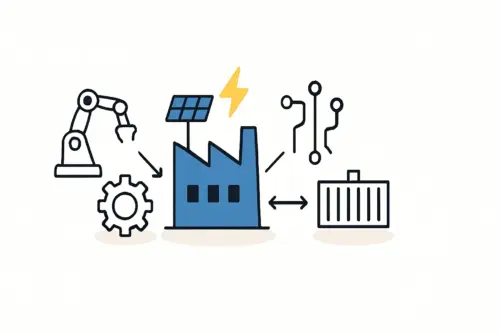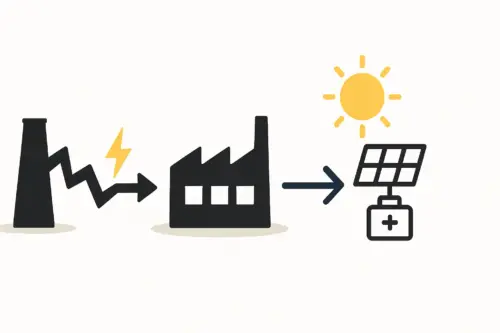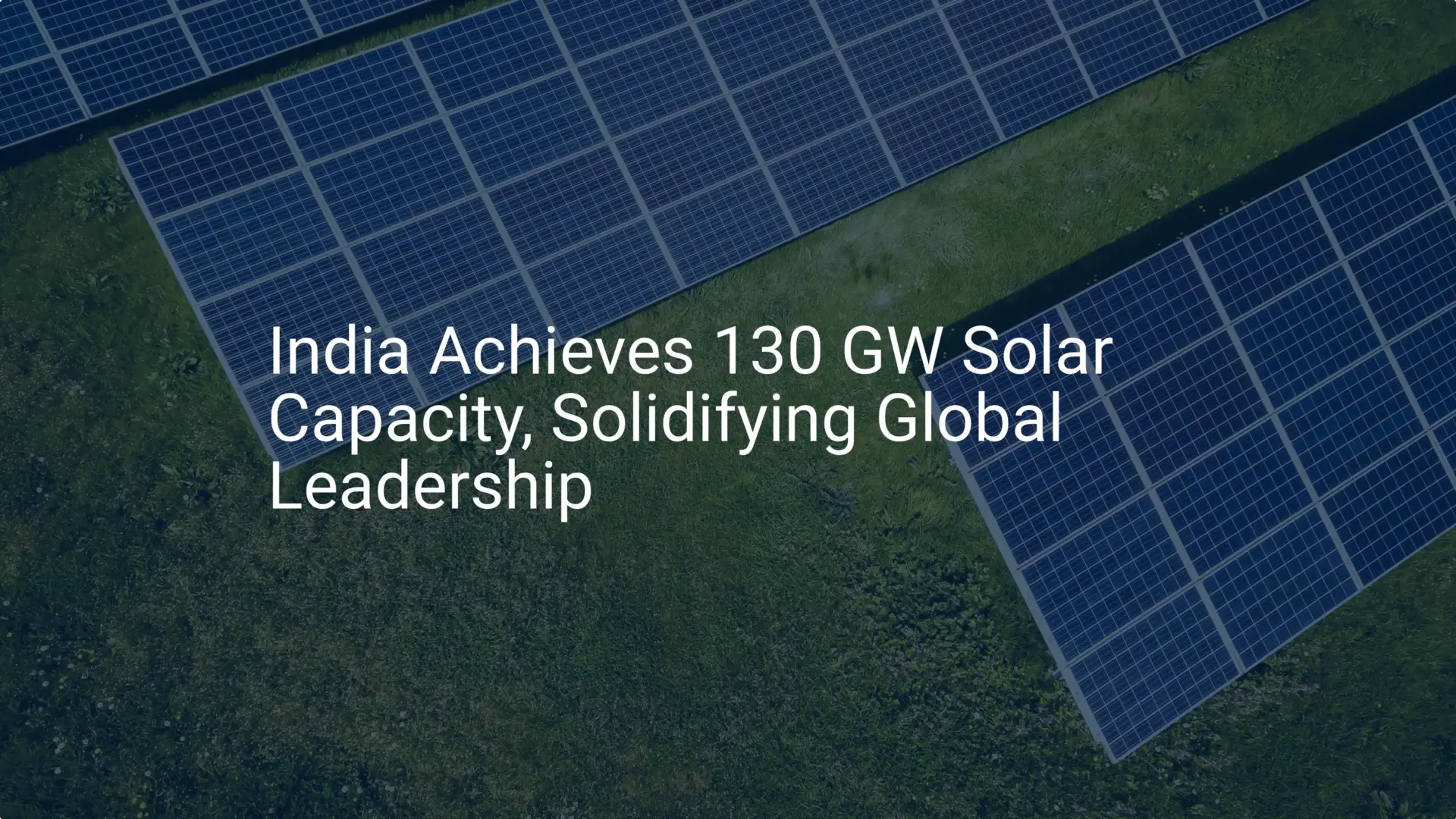The global shift towards renewable energy creates a significant manufacturing opportunity for international investors. Finding the ideal location to establish a competitive, export-focused production base, however, is a complex challenge.
While many regions offer incentives, few combine world-class logistics, a pro-business policy framework, and a robust industrial ecosystem as effectively as the state of Gujarat, India.
This analysis lays out the strategic case for establishing a solar module factory within one of Gujarat’s Special Economic Zones (SEZs), with a focus on the advantages of proximity to Mundra Port. It is intended for entrepreneurs and business leaders who recognize the potential in solar manufacturing but require a clear framework for market entry and operational excellence.
The Strategic Advantage of Gujarat for Solar Manufacturing
India’s ambition to become a global manufacturing hub, encapsulated in its ‘Make in India’ initiative, has created a highly favorable environment for industrial development. Within this landscape, Gujarat has emerged as a premier destination, particularly for export-oriented businesses. The state’s success is built on three core pillars:
-
Premier Port Infrastructure: Gujarat’s extensive coastline is home to some of India’s most efficient ports, with Mundra Port standing out as a logistical powerhouse. Its strategic location and capabilities are critical for any business reliant on international trade.
-
Pro-Business Governance: The state government has a long-standing reputation for facilitating industrial investment through clear policies, stable governance, and efficient administrative processes.
-
Developed Industrial Ecosystem: Gujarat offers a deep pool of skilled and semi-skilled labor, reliable power infrastructure, and a network of ancillary industries that support large-scale manufacturing operations.

However, it is the state’s Special Economic Zones that provide the most compelling advantage for an international investor focused on the global market.
Navigating the Special Economic Zone (SEZ) Framework
A Special Economic Zone is a specially demarcated geographical area within a country that is treated as a foreign territory for trade and customs purposes. The primary objective of an SEZ is to boost foreign investment and promote export-oriented production by offering a highly attractive fiscal and regulatory environment.
For a solar module manufacturer, setting up a unit within a Gujarat SEZ offers several decisive financial and operational benefits:
-
Duty-Free Procurement: All capital goods, machinery, raw materials, and components required for the factory can be imported or procured domestically without payment of customs duties. This benefit significantly reduces the initial investment required to start a solar panel factory by eliminating tariffs on critical equipment like stringers, laminators, and cell testers.
-
Tax Incentives: SEZ units benefit from substantial corporate income tax exemptions for a specified period, directly improving profitability and return on investment during the crucial early years of operation.
-
Simplified Compliance: SEZs operate under a more streamlined regulatory framework, often managed through a single-window clearance system. This simplifies the process of obtaining licenses, permits, and approvals, reducing administrative burdens and accelerating project timelines.
-
Infrastructure Support: SEZ developers provide high-quality, reliable infrastructure, including power, water, roads, and waste management. This support frees manufacturers to focus on their core operations. When considering the building requirements for a solar module factory, the pre-vetted infrastructure within an SEZ is a notable advantage.
Site Selection: Why Proximity to Mundra Port Matters
For an export-focused business, logistics are not merely an operational detail; they are a central pillar of the business strategy. Selecting a site within an SEZ near Mundra Port offers a powerful competitive edge in the global marketplace.
Mundra Port is India’s largest private port and a leader in container cargo handling. Its strategic advantages for a solar module exporter are clear:
-
Reduced Inland Logistics Costs: Proximity to the port dramatically reduces the time and expense of transporting finished modules from the factory to the vessel, lowering the risk of damage during transit and improving overall cost efficiency.
-
Faster Turnaround Times: Mundra Port’s advanced infrastructure and deep draft allow it to accommodate the world’s largest container ships, ensuring high-frequency connections to key markets in the Middle East, Africa, Europe, and North America. This translates to shorter lead times for international customers.
-
Streamlined Customs and Export Processes: SEZs are designed for seamless export operations. With dedicated customs clearance facilities, moving goods from the factory floor to international waters is significantly faster and more predictable than from a standard domestic unit.

Financial Modeling for an Export-Oriented Factory
A realistic financial model is essential for any investor considering how to start a solar panel manufacturing business. Gujarat’s SEZ framework positively impacts several key financial variables.
Capital Expenditure (CAPEX)
The primary CAPEX components are land, building, and machinery. The duty-free import of production equipment from global suppliers is the most significant cost advantage offered by the SEZ scheme. This allows the factory to be equipped with state-of-the-art technology without the burden of import tariffs, which can often be substantial.
Operating Expenses (OPEX)
-
Raw Materials: Key components such as solar cells, glass, encapsulants (EVA), and backsheets can be imported duty-free, leading to a lower per-module production cost.
-
Labor: Gujarat provides access to a large and cost-effective workforce. While management and specialized engineering roles may require higher compensation, the availability of trained technicians and line operators helps maintain competitive labor costs.
-
Logistics: Proximity to Mundra Port minimizes recurring inland freight and handling charges, a saving that accumulates significantly over thousands of shipments.
Revenue and Competitiveness
By lowering both initial investment and ongoing production costs, the SEZ model enables a Gujarat-based factory to price its modules competitively in the global market. This cost advantage, combined with high-quality production standards, creates a compelling value proposition for international buyers.
Assembling the Right Team and Technology
While location and policy are critical, success ultimately depends on execution—specifically, on combining the right technology with the right human expertise.
For an export business, product quality and international certification (e.g., IEC, UL) are non-negotiable. Selecting the right production machinery is therefore a foundational decision. Investors must choose equipment that not only meets current technology standards (such as for M10 or G12 cell sizes) but is also reliable and capable of producing modules that satisfy the stringent requirements of Western markets. This is where guidance on which machines are needed for a solar module production line becomes invaluable.
For entrepreneurs new to the photovoltaic sector, bridging the knowledge gap is essential. Based on experience from J.v.G. Technology GmbH’s turnkey projects since the 1990s, partnering with established engineering consultants can de-risk the venture. Such a partnership ensures that the factory layout, machine selection, process implementation, and quality control systems are designed to meet global standards from day one.

Frequently Asked Questions for Investors
What is the typical timeline from planning to production in a Gujarat SEZ?
With the streamlined single-window clearance in an SEZ, a well-planned project can move from land acquisition to the start of commercial production in approximately 12 to 18 months. This timeline includes factory construction, machine installation, and trial runs.
Can a factory in an SEZ sell solar modules within India?
Yes, but sales to the Domestic Tariff Area (DTA)—the rest of India outside the SEZ—are treated as imports. This means the buyer in India would have to pay the applicable customs duties, and the transaction must follow specific procedures. The primary focus of an SEZ unit remains exports.
How is quality control managed to meet international standards?
Quality control is a multi-stage process. It begins with sourcing certified raw materials and selecting high-precision machinery, continues with rigorous in-line quality checks (e.g., electroluminescence testing) at multiple points during production, and concludes with a final flash test and inspection for every module. A robust Quality Management System (QMS) is essential.
What are the main regulatory hurdles to be aware of?
While the SEZ framework simplifies many processes, investors must still adhere to Indian labor laws, environmental regulations, and specific SEZ compliance requirements. The key is to have a clear understanding of these obligations from the outset. Engaging with local legal and administrative experts is highly advisable.
Conclusion: A Strategic Path to Global Competitiveness
Establishing an export-focused solar module factory in a Gujarat Special Economic Zone near Mundra Port represents a uniquely powerful investment opportunity. The convergence of strategic location, world-class logistics, a favorable policy framework, and a supportive industrial ecosystem creates a formidable platform for global competitiveness.
This venture, while complex, is entirely manageable with diligent planning and the right expert guidance. For investors ready to take the next step, developing a detailed business plan is the logical starting point. Resources like the educational materials and courses available on pvknowhow.com can provide a comprehensive roadmap for this journey.





